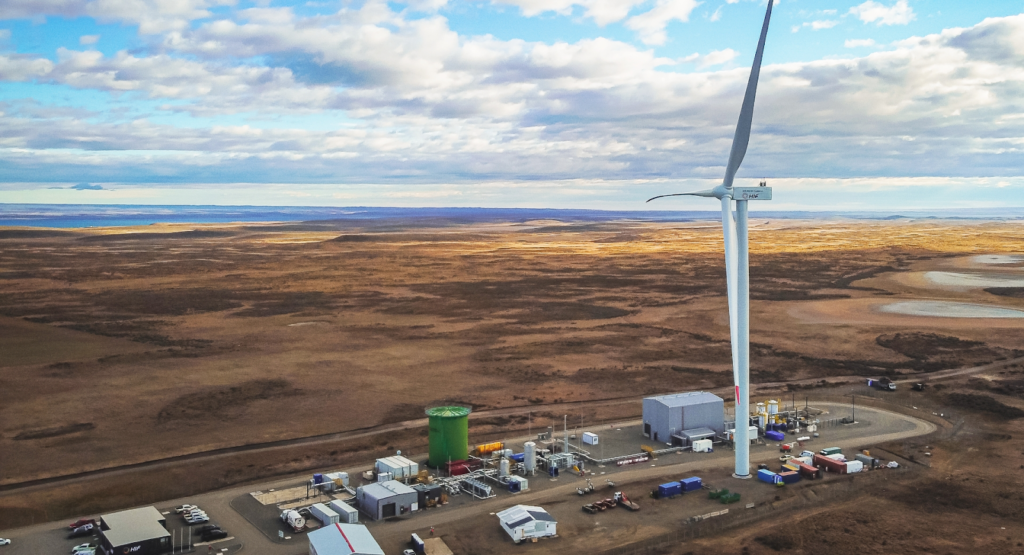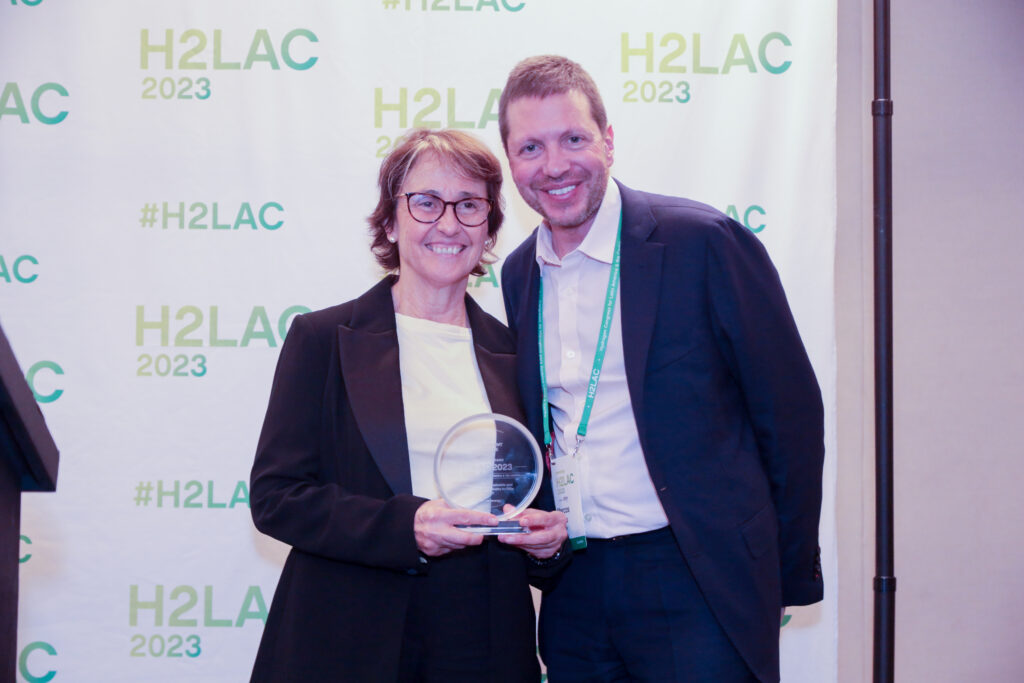

The fund, which is slated to open for business in 2024, is intended to reduce the costs and mitigate the risks of investing in this nascent industry. It will be implemented by the Chilean Economic Development Agency (Corporación de Fomento de la Producción, or Corfo), which is part of the Ministry of Economy, Development, and Tourism.
Corfo’s main interest in green hydrogen is in its economic development impact—its potential to contribute to GDP and generate employment, according to Ana María Ruz, Executive Director of the agency’s Green Hydrogen Industry Development Committee. That is especially important in parts of the country that will lose jobs due to the energy transition, she said, such as communities where coal-fired plants are being shut down.
Green hydrogen, she said, will also play an important role in Chile’s efforts to reduce its greenhouse gas emissions and meet its international commitments to decarbonize the economy. The new fund, she said, will help the country take a big step in that direction.
“We, as Corfo, expect the game to change, and the change in the game is reductions in emissions, better employment, and less pollution,” she said in an interview. She stressed that the fund will not provide subsidies or finance research and development but will support “real projects,” with the aim of reducing the financial and technical risks.
About three-quarters of the initial funding for the program, called a loan facility, will come from sovereign loans to the country from several development banks. Corfo will provide the remainder.
The biggest lender, the Inter-American Development Bank (IDB), is providing a US$400 million loan. Another $150 million will come from the World Bank. The European Investment Bank and Germany’s KfW Development Bank—together known as Team Europe for this purpose—will each put up €100 million.
The program will also receive a US$16.5 million grant from the European Union’s Latin America Investment Facility and close to $800,000 in technical assistance from the EU to support implementation.

European Commission President Ursula von der Leyen visited Chile in June to sign cooperation agreements on green hydrogen with Chilean President Gabriel Boric and other high-level officials. Credit: Chilean Hydrogen Association.
At the official launch of the loan facility in June, which was attended by the ministers of finance, energy, and the economy, Corfo Executive Vice President José Miguel Benavente said the $1 billion fund will seek to leverage $12.5 billion in financing for different types of green hydrogen projects.
Among the examples he gave: international projects to produce green hydrogen in Chile; investments to reduce emissions in certain traditional economic sectors, such as mining or agroindustry; and the development of value chains to support local economic growth, such as through local manufacturing of electrolysis equipment.
Corfo will not loan the money directly to project developers but will act as a second-tier lender, making favorable loans or guarantees available to commercial banks for projects that meet the defined criteria. With the backing of Corfo—and, ultimately, the development banks—commercial banks can fund such projects without taking on too much risk.
Each of the development banks participating in the program has its own priorities, requirements, and restrictions on what kinds of projects its loans or guarantees will support, and the terms will vary depending on the project and the lender, according to Ruz. In some cases, tax incentives may also be available.
Ruz said that Chile will never be able to offer such open-ended opportunities for hydrogen development as those provided in the United States under the Inflation Reduction Act, which establishes a tax credit of $3 per kilogram (kg) of clean hydrogen produced. However, she said, the support of development banks will make it possible to structure financing arrangements that will allow the industry to take off.
“We believe that the multilateral banks are utilizing us as a laboratory with this facility,” she said. “If it works in Chile, they will probably apply it to other countries in Latin America or the world.”

At the Third Hydrogen Congress for Latin America and the Caribbean, held in June in Rio de Janeiro, Ana María Ruz accepts an award on behalf of Corfo for best government initiative on green hydrogen. Pictured with her is Marcos Kulka of the Chilean Hydrogen Association. Credit: New Energy Events / H2LAC
Chile has been working on green hydrogen for several years and rolled out its strategy for the industry in 2020. Ruz said that most of the development in green hydrogen and derivatives will happen in two regions of the country: Antofagasta in the north, which has vast solar resources, and Magallanes in the south, which has wind power.
In the coming decade or two, Chile will have to drastically increase its production of renewable energy to accommodate economic growth, replace the energy from coal-fired plants, and produce green hydrogen on a large scale. “We need to triple the installed capacity [of renewable energy] that we have today,” Ruz said.
In Chile, this type of investment comes from the private sector, though many areas of government are involved in the coordination process necessary for projects to happen. The Green Hydrogen Industry Development Committee, of which Ruz is Executive Director, is led by an Interministerial Council that includes 11 government ministers and the head of Corfo.
Although the committee was created only last year, Corfo has been working on this topic since around 2019, “when nobody was talking about hydrogen,” Ruz said. The role that the agency will play in implementing the new green hydrogen fund, she said, will be similar to what it did in the case of the Cerro Dominador concentrated solar power plant built in the Atacama Desert.
According to a description by KfW Development Bank, which helped finance the project, the plant uses mirrors to concentrate sunlight onto a heat receiver at the top of a 250-meter tower; this heats up a fluid that then drives a steam turbine to produce electricity. The heated fluid can also be stored for hours, allowing the plant to keep operating without direct sunlight.

Cerro Dominador, a concentrated solar power plant in the Atacama Desert, was built thanks in part to concessional funding from international development banks and support from Corfo. Chilean officials envision a similar arrangement for green hydrogen projects. Credit: Grupo Cerro.
The plant, which opened two years ago, required a major investment in a technology that was new to Chile and to Latin America, Ruz said. Concessional funding from development banks, as well as support from Corfo, gave commercial banks the confidence they needed to fund the project, she said.
She expects that to happen as well with green hydrogen projects. The first investments, she said, will likely be in the tens or hundreds of millions of dollars, for projects with a capacity of up to 100 megawatts (MW). Eventually, the country could see investments in the billions of dollars in projects at gigawatt scale.
Right now, the only green hydrogen projects in operation in Chile are very small “isolated solutions” for particular circumstances, according to Ruz. For example, she said, Walmart uses green hydrogen fuel cells to operate forklifts at its Quilicura distribution center in Santiago. Hydrogen fuel cells are also used to store power for the base camp at the Cerro Pabellón geothermal plant in the Atacama Desert.
One area where green hydrogen could make a major difference in Chile is in the mining sector, Ruz said. For example, the massive mining trucks that now run on diesel could potentially run instead on green hydrogen. (The mining company Anglo American announced last November that it had deployed the world’s largest hydrogen-powered vehicle at a mine in South Africa.)
Enaex, a company that manufactures explosives used in the Chilean mining industry, sees green ammonia, a derivative of green hydrogen, as the way to reduce its carbon footprint. Ammonia is the main raw material Enaex uses, and currently it has to rely entirely on imports of ammonia made through a process that uses natural gas.
Enaex is now teaming up with the energy company ENGIE on a project called HyEx, which according to the Enaex website will use renewable energy to produce green ammonia. Production is expected to begin by 2025, and by 2030, the company plans to be producing 700,000 metric tons of green ammonia from a 2.8-gigawatt electrolysis plant—enough not only to supply its own needs but to export.
Ruz also mentioned the possibility that electrolysis equipment could someday be manufactured in Chile, especially given the worldwide shortages of such equipment today. The Green Hydrogen Industry Development Committee put out a request for information to gauge interest, and it has identified companies from Spain, Italy, Belgium, the United States, and China that may be candidates for setting up equipment production in Chile.
That kind of manufacturing operation would create real local value and high-quality jobs, as well as guarantee a supply for green hydrogen projects in the country, Ruz said. “I don’t know if we’ll be able to pull that off. I hope so,” she said.
 View Map
View Map